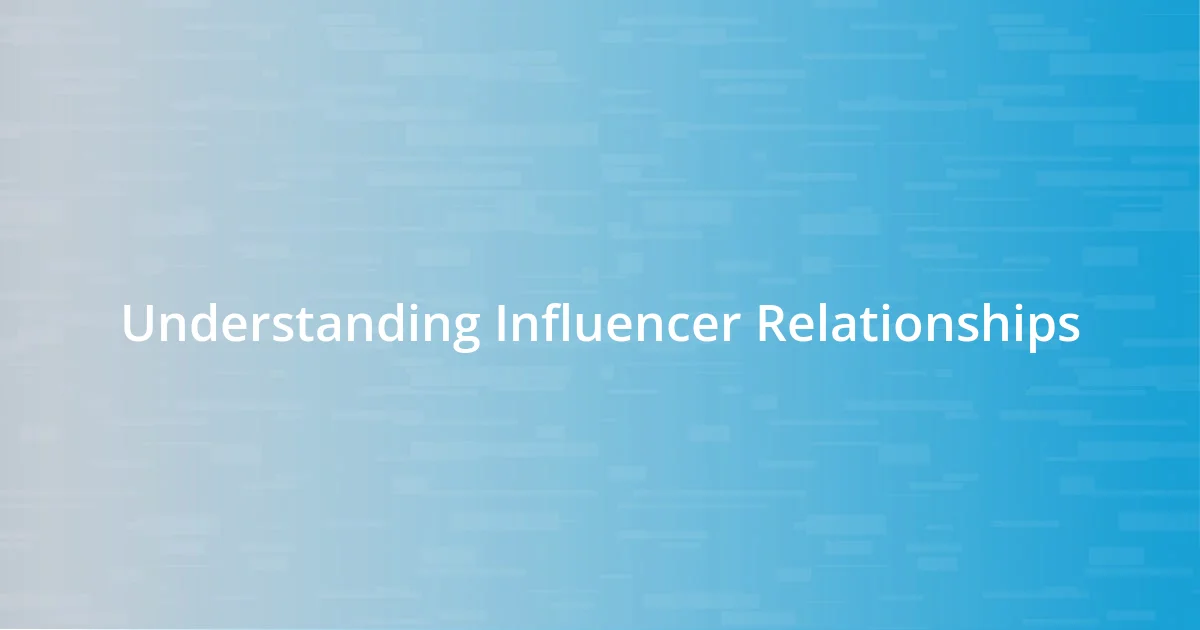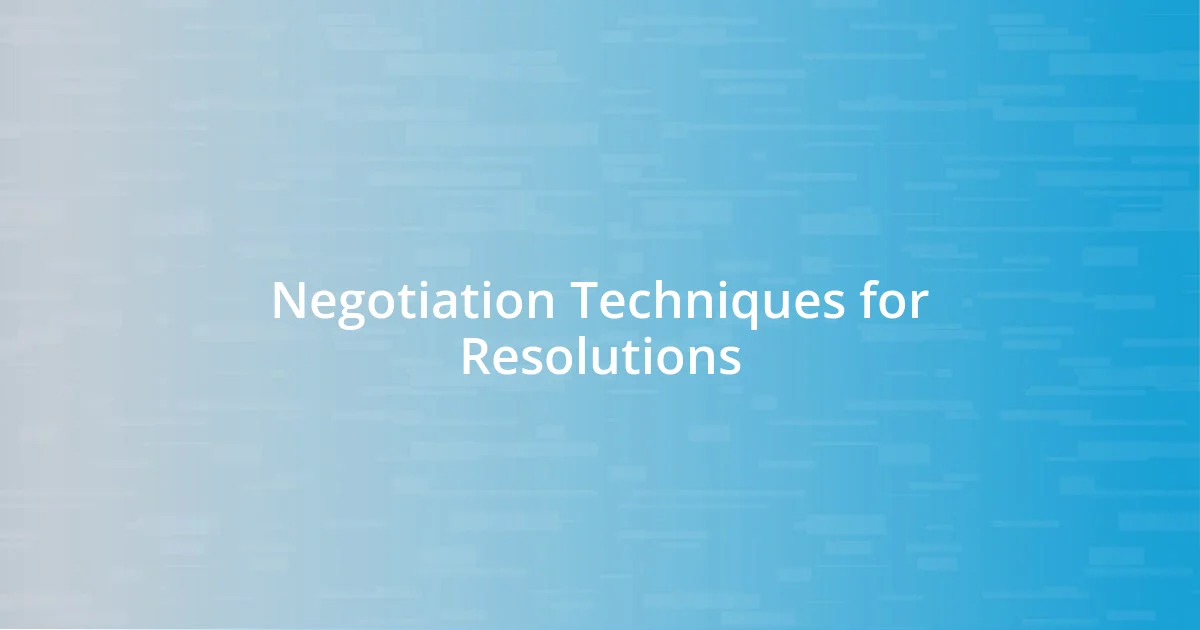Key takeaways:
- Building genuine relationships with influencers is crucial; aligning values and effective communication foster successful collaborations.
- Identifying and addressing key conflict areas—such as misaligned expectations, content ownership, and performance metrics—can prevent misunderstandings.
- Regular feedback and proactive discussions enhance partnerships; recognizing milestones and celebrating successes strengthens long-term relationships.

Understanding Influencer Relationships
Understanding influencer relationships is all about connection and authenticity. I remember when I first partnered with an influencer; the excitement was palpable. However, I quickly realized the importance of aligning values and brand messaging. Have you ever felt that rush of enthusiasm, only to find out later that the partnership just wasn’t a fit?
Building a genuine rapport with influencers can transform collaborations into thriving partnerships. For instance, I took the time to understand one influencer’s audience and the content they loved. By engaging with their community and showing genuine interest in their work, I found that trust blossomed. Have you experienced that moment when an influencer genuinely appreciates your brand? It’s a game-changer.
Finally, communication is key. I learned this through a misstep when I assumed an influencer understood our expectations without a thorough discussion. The stress and tension could have been avoided with clearer dialogue. Isn’t it fascinating how a simple conversation can bridge gaps and lead to more productive relationships?

Identifying Key Conflict Areas
Identifying key conflict areas in influencer partnerships is essential for a smooth relationship. One area I’ve often noticed is misaligned expectations. Early in my career, I worked with an influencer who had a vastly different vision for the campaign than I did. It led to a frustrating back-and-forth, as both parties were trying to understand each other’s point of view. Have you ever felt that disconnect where both sides were pulling in different directions?
Another common area of conflict can arise from content ownership and creative freedom. I had an instance where an influencer wanted full creative control, while I had specific brand guidelines I needed them to adhere to. This led to considerable tension, as I felt my brand’s messaging was at risk. It’s always a balancing act to maintain the authenticity of the influencer without stifling the brand’s identity. Have you encountered difficulties in negotiating these creative boundaries?
Lastly, performance metrics often spark disagreements. During one collaboration, I focused on engagement rates, while the influencer was more concerned about reach. This difference in priorities can lead to misunderstandings about the campaign’s success. Reflecting on these experiences, I’ve learned that proactive discussions around these key areas can prevent conflicts before they arise.
| Conflict Area | Description |
|---|---|
| Misaligned Expectations | Diverging visions can create tension in campaigns. |
| Content Ownership | Negotiating control with influencers requires careful balancing. |
| Performance Metrics | Differences in success measurement can lead to misunderstandings. |

Effective Communication Strategies
Effective communication lays the groundwork for a successful partnership with influencers. I once experienced a situation where a simple misunderstanding escalated into a significant conflict. I found that having regular check-ins not only helped clarify expectations but also fostered a sense of team spirit. It was like opening the lines of dialogue; suddenly, we were not just collaborators but allies working towards a common goal. Isn’t it amazing how a consistent conversation can strengthen relationships?
Here are a few effective communication strategies that I’ve found invaluable:
-
Active Listening: Focus on understanding the influencer’s perspective fully before responding. This will not only make them feel valued but can also reveal underlying issues.
-
Setting Clear Expectations: Clearly outline roles, deliverables, and boundaries from the start. This helps eliminate confusion down the line.
-
Using Positive Language: Instead of focusing on problems, frame discussions around solutions. This encourages a collaborative atmosphere.
-
Feedback Loops: Create opportunities for open feedback. I’ve learned that some of the best ideas come from these unfiltered discussions.
-
Empathy and Understanding: Approach conflicts with a mindset of empathy. Connecting on a personal level can soften tensions and transform the conversation.
In my experience, adopting these strategies not only enhances communication but helps eliminate misunderstandings, paving the way for smoother collaborations.

Negotiation Techniques for Resolutions
Negotiation is an art, and having a few techniques at hand can be a game-changer in resolving conflicts with influencers. For instance, when I faced a disagreement over detailed campaign execution, I employed collaborative problem-solving techniques. I sprawled out all our options on a table, transforming the conflict into a brainstorming session. Imagine how refreshing it felt to shift from defensiveness to a creative dialogue! It often surprises me how brainstorming can unveil solutions that satisfy both parties.
Time is of the essence, and I’ve found that being willing to compromise can turn a tense negotiation into a constructive conversation. There was a moment when an influencer pushed back on a deadline that I deemed crucial. Instead of insisting, I asked for their preferred timeline and found a middle ground. This not only met my deadline but also honored their creative process. Isn’t it funny how a small act of flexibility can lead to mutual respect?
Another powerful technique I’ve embraced is establishing a win-win framework. I recall a situation involving content ownership where both our interests seemed at odds. Instead of staking my claim, I pitched an idea where the influencer could showcase their creative input while still aligning with our brand guidelines. The smile on their face during that conversation said it all—it forged a deeper connection. How rewarding it is to find that sweet spot where both parties walk away feeling heard and valued!

Building Long-Term Partnerships
Building long-term partnerships with influencers has been one of the most fulfilling experiences in my career. I remember a time when I invested in nurturing a relationship with a creative who initially seemed distant. By inviting them to share their thoughts on our campaigns regularly, I discovered what truly motivated them. It was like peeling back layers to reveal not only a dedicated professional but also a genuine passion for storytelling. Has there ever been a time when you realized the power of simply listening? It changes everything.
Creating an environment of mutual respect is essential. I once collaborated with an influencer who pushed boundaries in their content—something I initially struggled to embrace. After several candid conversations about their vision and my brand values, I learned that accommodating their unique style added an authentic charm to our campaigns. This willingness to adapt transformed our partnership from transactional to collaborative, paving the way for future projects that benefited us both. How astonishing is it when you allow creativity to flourish rather than impose restrictions?
Finally, recognizing milestones in our partnership has often deepened our connection. I vividly recall celebrating the completion of our third campaign together with a small virtual gathering. Acknowledging each other’s contributions turned that moment into a cornerstone of our relationship. Since then, we’ve continued to grow together, knowing that our journey is not just about individual projects but a shared legacy. I can’t help but feel that these little gestures truly nourish long-term partnerships. Have you ever thought about how celebrating success, no matter the size, adds richness to your collaborations? It’s the glue that holds everything together.

Learning from Past Conflicts
Reflecting on past conflicts has taught me invaluable lessons. In one instance, I clashed with an influencer over creative direction. Instead of withdrawing, I took a step back and analyzed the root of our disagreement. This reflection revealed that my expectations were unclear, leading me to consider how communication could prevent similar issues in the future. Have you ever overlooked simple miscommunications that spiral into larger conflicts?
I’ve also realized that emotions often drive disagreements. I recall a heated conversation where frustration clouded our judgment. After that experience, I made it a point to acknowledge emotions during discussions. By creating space for both of us to express our feelings, we transformed tension into understanding. Isn’t it fascinating how allowing vulnerability can build bridges rather than walls?
Finally, I’ve learned the importance of documenting outcomes and insights from conflicts. After navigating through a particularly tricky negotiation, I started keeping notes on what strategies worked and what didn’t. This has not only helped me refine my approach but has also equipped me to coach others facing similar challenges. Have you ever considered how recording your experiences can serve as a valuable resource for your future endeavors?

Measuring Conflict Resolution Success
Measuring the success of conflict resolution is critical in my journey as a collaborator. One method I find effective is assessing the quality of our ongoing communication after a conflict. For instance, after navigating a challenging disagreement, I noticed that our conversations became far more open and constructive. This shift not only revealed that we had moved past the issue, but it also strengthened our ability to tackle future challenges together. Have you ever evaluated how your dialogue changes once a conflict has been resolved?
Another approach I use is tracking the impact on our joint projects. It’s fascinating to observe signposts that reflect our renewed partnership. In one instance, after resolving a disagreement about campaign metrics, our next collaborative project exceeded previous engagement levels as we worked in sync. This outcome felt like a direct reward for overcoming obstacles, which made me wonder—how often do we attribute success solely to improved chemistry after a conflict?
Lastly, feedback loops play a vital role in my measurement process. I regularly check in with influencers to gauge their feelings about our collaboration post-resolution. In a recent survey, one influencer shared that our conflict allowed them to express their concerns openly, ultimately leading to a more fulfilling partnership. This insight reaffirms how truly understanding each other’s perspectives can be transformative. Have you actively sought feedback after resolving issues to build a more solid foundation?
















